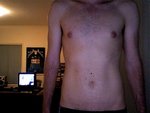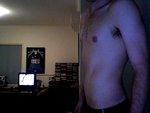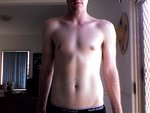( I have wrote all this in one form or another in other threads, and since it gets askes so much, I have saved alot of this to repost for others that have a need. Some is freshly written today)
Cutting body Fat:
The road to your goal, is gaining knowledge of calories and nutrition within a diet proportioned to your age, wgt, hgt, and gender, which includes associated activities. Then developing a scheduled training plan per week (which allows recuperation time) that compliments this clean diet. When both are developed, then the key is consistency and then watching, looking, and being very mindful, of your bodily responses to your diet and training stimulus.
Deficit dieting is the fat burner, and EVERYTHING follows after this. The deficit can be implemented through the diet or exercise can cause the deficit when you know your MT line reference. If you stick to the basic: The Law of energy balance, and tip this to the negative side of the equation, you will be on your way, with everything considered equal and your healthy.
In the end of the 24 hour day, all that calorically matters is the law of energy balance: Whether you Maintained an approximate balance, surplus, or deficit. When we are talking Gain or Loss of Tissue weight.
==========================================================
Since this is so fundelmental but SO IMPORTANT, I have saved this information to stave off writing time, I hope you dont mind:
This is what you need to do:
1. Get the diet right
2. Have a training schedule each week (that involves full body)
=========================================================
Deficit dieting is the MAIN thing that does the job.
Some Basic information that can lead you to fat tissue loss
Calorie calculation is an approximation science, remember this. Through your journey WATCH, LOOK, and LISTEN, to your body..........it will TELL YOU if your doing the correct things or combination of things!
○ Change your eating habits (below are some suggestion examples)
○ Substitute an artificial sweetener of your choice in the replace of refined white sugar (Refrain from Refined Sugar like you would a disease)
○ Try eating 5 to 6 smaller meals during the day
○ Balance your meals out during the day so in one day you have a mix of protein, carbohydrate and good fats
○ Drink lots of water during the day and before, during and after exercise
○ Simple Carb Examples: Grapefruit, Watermelon, Cantaloupe, Strawberries, Oranges, Apples, Pineapple, etc
○ Complex Carb Examples: Whole Wheat Pita Bread, Oatmeal, Long Grain Brown Rice, Brown Pasta, Malto-Meal (Plain, whole wheat),etc
○ Good Protein Examples: White or Dark Tuna, Chicken Breast, Lean Turkey, Lean Ham, Very lean Beef, Quality Whey Protein Powder,, etc
○ Good Fats Examples: Natural Peanut Butter, Various Nuts, Flax Seed, Fish Oils.
This is what you need to do:
This an approximation science, but you can narrow it down very close, if your meticulous in your vision when looking at the data.
Tweak your desire and passion by educating yourself on the basic requirements of losing fat tissue. With your age, sex, height, and weight, in mind, find your approximated base calorie needs (this is organ function, breathing, or bodily function needs). One can use the Benedict Formula.
Calculate your BMR:
The Harris Benedict equation determines calorie needs for men or woman as follows:
• It calculates your Basal Metabolic Rate (BMR) calorie requirements, based on your height, weight, age and gender.
• It increases your BMR calorie needs by taking into account the number of calories you burn through activities such as exercise.
This gives you your total calorie requirement or approximated Maintenance Line (I call it the MT Line).
Step One : Calculate your BMR with the following formula:
•Women: BMR = 655 + (4.35 x weight in pounds) + (4.7 x height in inches) - (4.7 x age in years)
•Men: BMR = 66 + (6.23 x weight in pounds) + (12.7 x height in inches) - (6.8 x age in years)
Step Two : In order to incorporate activity into your daily caloric needs, do the following calculation:
•If you are sedentary : BMR x 1.2
•If you are lightly active: BMR x 1.375
•If you are moderately active (You exercise most days a week.): BMR x 1.55
•If you are very active (You exercise daily.): BMR x 1.725
•If you are extra active (You do hard labor or are in athletic training.): BMR x 1.9
Create a Calorie Deficit:
In order to lose weight, you must create a calorie deficit. It is easier and healthier to cut back your calorie intake a little bit at a time.
Every 3,500 calories is equivalent to approximated 1 pound.
If you cut back 500 calories a day, you will lose approximated 1 pound per week. (not necessarily all fat)
If you exercise to burn off 500 calories a day you will also lose approximately 1 pound per week.
The calorie deficit margin is just an example:
Apply this knowledge by backing off the approximated MT Line (approximated Maintenance line), say for example, a -500c per day, for about 1 week. Before the week begins, weigh yourself in the AM when you FIRST get up (do not eat yet) (remember your clothing, preferably with just underwear and t-shirt or like clothes). Note the time, and the approximated wgt.
Each day spread your caloric content out throughout the day (keep the body fed, with calories in the 300 to 500c approximated calories each meal), or a like division which mirrors your end caloric deficit limit (meaning MT-500c).
This way you have your entire day and body encircled with nutrition (I assume you already know to eat clean), which if your eating right, will give an approximated good energy (not optimal because your in deficit) to fuel your training and exercising schedule.
At the end of the week, on the same day, the same time, with the same like clothes, weigh yourself again. Note whether you lost or gained tissue (or weight I mean). To further assist you, I want to tell you that for every approximated caloric deficit of (-3500c), one could lose 1lb of fat tissue. (though some may not all be fat tissue, this information is for another question, and isn't presently suited here).
Now, in this example you were calculating a -500c per day deficit. There needs to be -3500c to lose approximated 1lbs of fat. Now lets do some basic math. -500cX7=-3500c. With all things considered equal, and you were meticulous and faithful on the diet, you should have been CLOSE to losing at least one pound of tissue in the week.
If this didn't happen, this means you need to make finer adjustments, and the MT line is not accurate, and you need to adjust this on your own.
Based upon the FEEDBACK your body is giving you, ask yourself how faithful you were on the diet, AND how faithful in training (whether you kept the training schedule (if you didn't, this would effect the caloric equation, no?!), AND how accurate you figured in your activities caloric wise.........but, you have the base information to begin making adjustments.
=========================================================
The Nutrients are an essential factor in the diet; however, the law of energy balance within the DIET, is the ultimate KING while the Nutrients can play in some decisions made within the body.
Do yourself a favor, figure out your MT line, adjust off of this, eat well balanced spaced out meals (DONT EVER starve YOURSELF), AND listen to your body for the results.
While you are trying to figure out your body, IT WILL PAY YOU BACK, I promise. You have to learn to MASTER yourself to become the master of weight loss for YOURSELF.========================================================
"Let your inner vision cultivate your ultimate exterior expression" —Chillen
"The strongest inner feeling that prevails will result in the exterior expression" –Chillen
"Your cultivation and manifestation of thought accumulated within your reasoning will determine your outcome"----Chillen
==========================================================
Deficit dieting is the fat burner, and EVERYTHING follows after this. The deficit can be implemented through the diet or exercise can cause the deficit when you know your MT line reference. Without a adequate deficit, cardio WILL NOT burn fat off you. This is WHY I don't partake in the cardio debates of heart rate, etc........because the bottom line is the deficit diet....period, debate OVER. If you stick to the basic: The Law of energy balance, and tip this to the negative side of the equation, you will be on your way, with everything considered equal and your healthy.
Losing fat is sort of like draining a pool. It usually leaves the shallow end first before the larger end starts to diminish. But, fat and/or tissue is lost all over when deficit dieting.
If you want to lose overall body fat, get your diet in order, eat clean, learn what your approximate MT reference line is according to activities (and back off a HEALTHY margin), and perform overall weight training, and of course, include cardio (cardio DOES have its benefits other than burning calories, carbs, fat, ect).
The most effective beginning is to look at your diet, and make a diet journal in my opinion, THEN work in a training program around this diet.
==========================================================
Controlled obsession is important (and obsession to a---Point, is critical), but some lose this obsession once they learn the amount of work it requires. There eyes then widen and then the obsession then pops right out. Dont let this happen to you: Raise your Want-o-Meter to a new higher level.
==========================================================
Weight progression EXAMPLE:
A Weight Program is a structured "Weight Lifting" Plan that you schedule certain exercises for a given time period.
For example: Monday, Wednesday, Friday, and Rest Saturday and Sunday, and then repeat.
For example (for simplicity's sake), schedule a full body workout on Monday, Wednesday and Friday, and then rest on the weekend. The program should be complimenting the sort of diet you have and the goals you seek.
I recommend a writing down the exercises, weight being used, and then keeping track of the reps completed---to track progression, and if need be enable FORCE progression techniques. The KEY to training, is PROGRESSION. Trying with FULL THROTTLE to progress from one workout to the next (whether its an increase in reps or weight or both).
For example: you used 100lbs on Bent Over row and did 8 reps. The next workout with the back you want to get 9 reps, and so on and so forth. If the target cut off rep range is 12 (for example), then you would increase about 5 lbs. This is progression in its simple basic form.
I hope this helps you in some way..........ROCK ON!!!!!!!!
Best Regards,
Chillen




